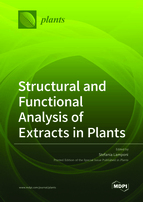Structural and Functional Analysis of Extracts in Plants
A special issue of Plants (ISSN 2223-7747). This special issue belongs to the section "Phytochemistry".
Deadline for manuscript submissions: closed (30 November 2020) | Viewed by 130189
Special Issue Editor
Interests: drug discovery; natural products; bioactive molecules; functional foods; nutraceuticals; in vitro biological tests; carriers for bioactive molecules; bioactivity
Special Issues, Collections and Topics in MDPI journals
Special Issue Information
Dear Colleagues,
The journal Plants will be publishing a Special Issue on Structural and Functional Analysis of Extracts in Plants. Plant extracts are extremely complex pools of phytochemicals and, together with their metabolites, are useful for a multitude of applications in different fields. Natural products from plants, either as pure compounds or as standardized extracts, provide unlimited opportunities for new drug leads because of the unmatched availability of chemical diversity. Their pharmacological interest is twofold: as a source of novel compounds that can be used as therapeutic agents able to overcome negative side effects of synthetic drugs, and as a model for the synthesis of new drugs with the best efficacy. Plant extracts, however, have an increasing importance also in the food market because they can be added in processed foods, contributing to the creation of an alternative to synthetic antioxidants, to improve food preservation and/or nutritional content, and to formulate functional products for people who need special diets. Even the cosmetic industry has an increasing interest in plant extracts. The inclusion of antioxidants in topical formulations can contribute to minimize oxidative stress in the skin, which has been associated with aging.
The use of plant extracts in all these areas depends on their bioactivity and, therefore, their composition, which is closely related to the extraction method. Extraction is in fact the most important step in plant extract preparations, and the use of different extraction techniques determines the bioactive compounds present. Since bioactive compounds occurring in plant material consist of multicomponent mixtures, their separation and identification are fundamental processes in the structural analysis of extracts. Finally, the analysis of the plant extracts and/or purified bioactive compounds, involving the applications of common phytochemical and in vitro biological screening assays, is essential for the correlation of structure with function of extracts in order to identify their bioactivity for targeted applications.
Thus, considering the great interest in plant extracts, this Special Issue will cover several aspects of their structural and functional analysis in order to correlate extraction techniques with chemical composition of extracts and their bioactivity for elucidating the characteristics of plant-derived compounds that might be used as active substances in a wide variety of areas.
Dr. Stefania Lamponi
Guest Editor
Manuscript Submission Information
Manuscripts should be submitted online at www.mdpi.com by registering and logging in to this website. Once you are registered, click here to go to the submission form. Manuscripts can be submitted until the deadline. All submissions that pass pre-check are peer-reviewed. Accepted papers will be published continuously in the journal (as soon as accepted) and will be listed together on the special issue website. Research articles, review articles as well as short communications are invited. For planned papers, a title and short abstract (about 100 words) can be sent to the Editorial Office for announcement on this website.
Submitted manuscripts should not have been published previously, nor be under consideration for publication elsewhere (except conference proceedings papers). All manuscripts are thoroughly refereed through a single-blind peer-review process. A guide for authors and other relevant information for submission of manuscripts is available on the Instructions for Authors page. Plants is an international peer-reviewed open access semimonthly journal published by MDPI.
Please visit the Instructions for Authors page before submitting a manuscript. The Article Processing Charge (APC) for publication in this open access journal is 2700 CHF (Swiss Francs). Submitted papers should be well formatted and use good English. Authors may use MDPI's English editing service prior to publication or during author revisions.
Keywords
- plant extracts
- phytochemicals
- natural food additives
- bioactive compounds
- in vitro biological screenin
Related Special Issue
- Structural and Functional Analysis of Extracts in Plants III in Plants (39 articles)







